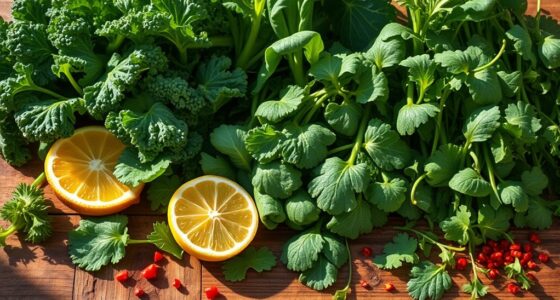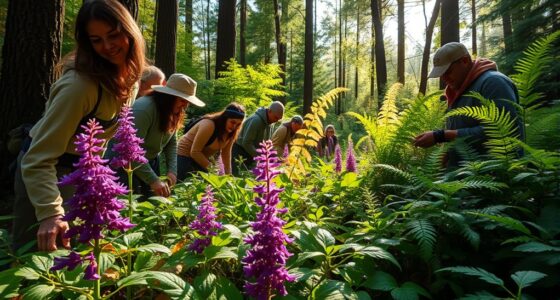You're likely wondering how forage and fodder differ, and why it matters for your livestock's nutrition. The key difference lies in their production and purpose. Forage refers to plants like grasses, legumes, and browse plants that animals graze on in the field, providing a wider range of nutrients. Fodder, on the other hand, is harvested feed like cereals and legumes, which are higher in protein and nutrients. Understanding the distinctions between forage and fodder helps you select the right feed for your livestock's specific needs, and manages your farm's resources more effectively. By exploring the differences, you'll uncover the secrets to optimizing your livestock's health and productivity.
Key Takeaways
- Forage refers to plants like grasses, legumes, and browse plants that animals graze on in the field, whereas fodder is harvested feed like cereals and legumes.
- Forage typically has higher fiber content, benefiting digestive health, whereas fodder is nutrient-dense and higher in protein, ideal for protein-rich diets.
- Forage generally has lower energy levels compared to fodder, and nutrient requirements vary based on factors like age, weight, and activity level.
- Forage is consumed immediately, providing a wider range of nutrients, whereas fodder requires preservation methods like drying or fermenting to maintain nutritional value.
- The choice between forage and fodder crops depends on factors like available space, livestock needs, and management resources, with forage suitable for larger areas and fodder ideal for limited spaces and specific nutritional needs.
Defining Fodder and Forage
When it comes to feeding your livestock, understanding the difference between fodder and forage is essential, as it directly impacts the nutrition and well-being of your animals.
You may think they're interchangeable terms, but they've distinct meanings. Fodder refers to harvested feed for your livestock, such as crops like cereals and legumes grown specifically for animal feed.
On the other hand, forage includes plants that your animals browse on in the field, like grasses, legumes, and browse plants. These plants provide essential nutrients for livestock and play a vital role in maintaining their health and productivity. Understanding how forage works is key to optimizing grazing practices and ensuring a balanced diet for your animals. By managing the quality and availability of forage, you can promote sustainable grazing systems that benefit both the ecosystem and your livestock’s well-being.
As a livestock owner, it's important to understand the difference between these two terms.
Grazers like sheep primarily consume forage, while browsers like goats prefer browsing on a variety of plants.
By knowing what type of feed your livestock needs, you can select the appropriate plants for their diet and manage your pastures efficiently.
This knowledge will help you make sure your animals receive the proper nutrition they need to thrive.
Plant Growth Stages Matter

You'll find that different plant growth stages greatly impact the nutritional value and safety of your forage and fodder. As you explore the world of animal feed, understanding these stages becomes essential for optimizing nutrition and safety for your livestock. Native plants, for instance, offer varying nutritional benefits at different growth stages, making it vital to monitor their development.
When it comes to forage, you'll want to take into account the growth stage of the plants your animals browse in the field. Are they in the vegetative, reproductive, or mature stage? Each stage affects the nutritional value of the food source, and knowing when to harvest or allow grazing will make a significant difference in the quality of the forage.
For fodder, timing is equally important. Harvesting at the right stage ensures the best possible nutritional content for your animal feed. By recognizing the plant growth stages, you can provide your livestock with the most nutritious food possible, leading to healthier and more productive animals.
Nutritional Content Compared

How do the nutritional profiles of forage and fodder stack up against each other? When it comes to feeding your livestock, understanding the differences in nutritional content is essential.
You've got open space, plants around, and animals to feed around the world, but what's the best choice for their dietary needs?
Here's a breakdown of the key differences:
- Fiber content: Forage typically contains higher fiber content, which can be beneficial for digestive health, but may not provide as much energy for your animals.
- Protein levels: Fodder, on the other hand, is often more nutrient-dense and higher in protein, making it an excellent choice for livestock requiring a protein-rich diet.
- Energy levels: Forage generally has lower energy levels compared to fodder, which can impact the overall energy needs of your animals.
Harvesting and Preservation Methods

Generally, you'll find that the way you harvest and preserve forage and fodder greatly impacts their nutritional value and overall usefulness in your livestock's diet.
When it comes to forage, you'll typically let your livestock graze on the plants in their natural state, allowing them to consume the plants fresh. This method provides a wider range of nutrients compared to preserved fodder.
On the other hand, fodder requires specific preservation methods like drying or fermenting to maintain its nutritional value. This is because fodder is cut and preserved for later use, unlike forage which is consumed immediately. The preservation methods used for fodder are essential in maintaining its nutritional value, ensuring your livestock receives the nutrients they need.
Livestock Feed Requirements

As you navigate the world of livestock feed, you'll need to understand the specific nutrient requirements and energy needs of your animals.
You'll want to assess their energy needs, taking into account factors like growth rate, pregnancy, and lactation.
Nutrient Requirements
When formulating a livestock diet, you must consider the specific nutrient requirements of your animals, which vary depending on factors such as age, weight, and activity level. Meeting these requirements is essential for the best growth, reproduction, and overall health of your livestock.
Properly formulated feed rations are vital to meeting the specific nutrient needs of different types of livestock. Deficiencies or excesses in nutrients can lead to health issues or reduced productivity in animals.
Here are three key components of a balanced livestock diet:
- Protein: essential for growth, maintenance, and reproduction
- Energy: necessary for maintenance, growth, and production
- Vitamins and minerals: crucial for various bodily functions, such as bone development and immune function.
Energy Needs Assessed
Evaluating your livestock's energy needs is essential, as it directly impacts their overall health, growth, and productivity. Factors like age, weight, activity level, and environmental conditions all play a role in determining their energy requirements.
You'll need to take into account the different stages of your livestock's life, as energy needs vary between maintenance, growth, reproduction, and lactation. To make sure you're providing the right amount of energy, you can calculate the Total Digestible Nutrients (TDN) of their feed. This will give you an accurate measure of the energy value of the forage or fodder you're providing.
Production and Storage Costs

As you consider the production and storage costs of forage crops, you'll need to factor in labor requirements, including the time and effort it takes to harvest, dry, and store the crops.
You'll also need to account for equipment expenses, such as the cost of tractors, balers, and other machinery needed for harvesting and storing the crops.
Labor Requirements
By opting for forage production, you'll typically spend less time and money on labor, thanks to the minimal planting and maintenance needs of these crops. This is because forage crops like alfalfa require occasional cutting and baling, reducing ongoing labor demands. In contrast, fodder production involves higher labor costs for sowing, harvesting, and storing feed.
Here are three key differences in labor requirements between forage and fodder production:
- Lower labor needs for planting and maintenance: Forage crops require minimal care, reducing labor costs and time spent on crop management.
- Less frequent harvesting and storage: Forage crops can be grazed directly in the field, decreasing the need for storage facilities and reducing labor costs associated with harvesting and storing.
- Reduced labor for crop rotation: Forage crops often have longer crop rotation cycles, reducing the need for frequent planting and harvesting, and resulting in lower labor costs.
Equipment Expenses
You'll also need to factor in equipment expenses, which can add up quickly in forage production, from mowers and balers to storage facilities and maintenance costs. These expenses can eat into your profit margins if not carefully considered.
Mowers, balers, and rakes are important for harvesting and preparing forage, and their costs can add up quickly. Additionally, you'll need to factor in storage costs, including expenses for silos, hay barns, and bale wrappers. Proper storage facilities are vital to maintaining forage quality and preventing spoilage.
Machinery maintenance and repair costs are also a significant expense, as breakdowns can lead to costly delays and losses. To optimize forage production efficiency, it's crucial to calculate equipment costs accurately. By factoring in these expenses, you can create a realistic budget and make informed decisions about your forage production operation.
Environmental Impact Considerations

When it comes to environmental impact, your crop choices can greatly mitigate or exacerbate ecological issues, making it essential to understand the differences between forage and fodder. As a farmer, you play a significant role in preserving the ecosystem. Forage crops, with their deep root systems, can aid in soil erosion prevention and improve soil health. On the other hand, fodder crops like alfalfa require less water, making them suitable for arid environments.
Here are three key considerations to keep in mind:
- Soil management: Regular application of nitrogen and manure is vital for maintaining the nutrient content and quality of forage crops. Monitoring and managing soil pH levels is also critical for optimizing growth and productivity.
- Crop maintenance: Proper maintenance of forage and fodder crops, such as washing seeds before planting and providing adequate space for growth, can help prevent issues like mold development.
- Water conservation: Fodder crops like alfalfa require less water, making them a more water-efficient option, especially in arid environments.
Crop Management Strategies

To guarantee maximum yields and crop quality, implementing effective crop management strategies is essential, especially regarding soil preparation, seed selection, and growth monitoring.
You'll want to start by testing your soil's pH levels regularly to secure ideal conditions for your forage and fodder crops. Additionally, applying nitrogen and manure will help maintain your crops' health and productivity. Don't forget to monitor and manage soil acidity levels, as this can greatly impact your crop's success.
When it comes to seed selection, proper cleaning and preparation of cereal crop seeds before planting can make a significant difference in your yields. Providing adequate space for your crops to grow will also help prevent issues like mold development.
Choosing the Right Feed Option

Choosing the appropriate feed option for your livestock can greatly influence their health, productivity, and overall well-being. As a farmer, understanding the differences between forage and fodder is crucial to making an informed decision.
When deciding between the two, consider the following factors:
- Space and land availability: If you have a larger area, forage crops might be a better option, allowing your livestock to graze freely. However, if you have limited space, fodder crops are more suitable.
- Livestock needs: If you have specific nutritional requirements for your livestock, fodder crops like alfalfa can be tailored to meet those needs. Forage crops, on the other hand, provide a more general nutrient profile.
- Maintenance and management: Both forage and fodder crops require proper maintenance, including soil pH testing and nitrogen application. Be sure you can dedicate the necessary resources to upkeep your chosen feed option.
Frequently Asked Questions
What Is the Difference Between Feed and Fodder?
When you wonder about the difference between feed and fodder, know that feed is a broad term for any food given to animals, while fodder refers specifically to harvested and stored feed, like hay or silage, that's provided to livestock.
What Is the Difference Between Crops and Forages?
As you step into the verdant fields, you'll discover that crops are cultivated for human consumption, whereas forages, like lush grasses and legumes, are specifically grown to nourish your livestock friends, providing them with essential nutrients for a healthy diet.
What Is the Difference Between Fodder and Silage?
You're wondering what separates fodder from silage; well, you'll find that silage is a specific type of fodder made from fermented crops, stored airtight to facilitate fermentation, whereas fodder is a broader term for any animal feed.
What Are Two Characteristics of Forages?
You'll notice that forages, as an integral part of livestock diets, typically have two key characteristics: they're high in fiber, supporting healthy digestion, and rich in essential vitamins and minerals, promoting overall animal well-being.
Conclusion
As you navigate the world of livestock feed, remember that forage and fodder are like two paths in a forest, each leading to a different destination. Choose the right path, and your animals will thrive. Choose incorrectly, and the consequences can be costly.
By understanding the differences between forage and fodder, you'll be better equipped to make informed decisions, ensuring the health and well-being of your livestock, and the success of your agricultural endeavors. Forage refers to natural plants that livestock can graze on directly from pastures, while fodder typically consists of harvested and processed feed like hay or silage. Understanding how forage works helps in optimizing grazing patterns, ensuring that animals receive balanced nutrition from their natural environment. By strategically managing both forage and fodder resources, farmers can boost productivity and maintain the sustainability of their land.










